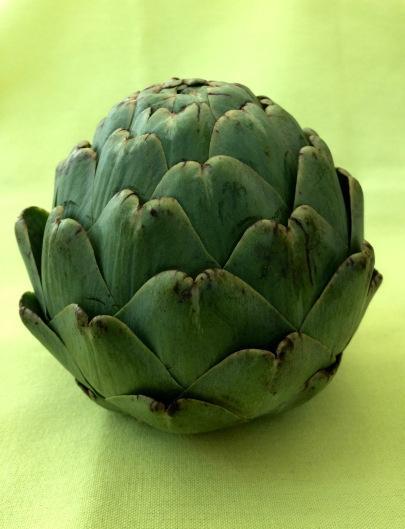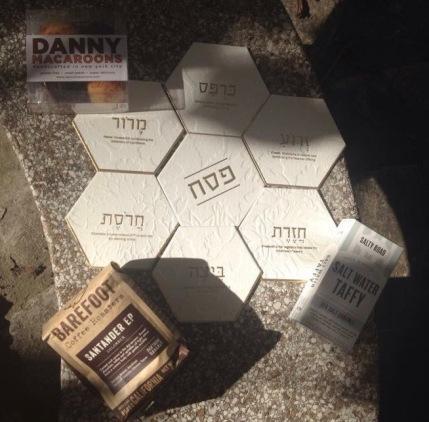
Artichoke Photo by Susan Katz Miller
An orange? A beet? An olive? A tomato? And, new for this year, a banana? Contemporary Jewish thinkers have encouraged us to innovate on Passover, to push the boundaries of the seder plate, to incorporate new objects and themes, and expand on the idea of the “we” in the Haggadah text.
But an artichoke on the seder plate? Not for me. As much as I appreciate the proposal to acknowledge interfaith families, I reject the nomination of the artichoke for this role. The suggestion of an artichoke dates back a decade, but resurfaced this year in a jazzy new video explaining seder plate symbols. In my view, the artichoke symbol fails, because the net effect excludes rather than includes, by re-enforcing the narrative of interfaith families as problematic.
The first paragraph of my book describes my own interfaith family Passover seder, with Jews, Catholics, Protestants, Buddhists, and atheists celebrating together. All are welcome at my table. In order to be as inclusive as possible, I like to emphasize the musical and poetry and storytelling, the English language, and the universal themes of social justice, religious freedom, and spring rebirth.
At the same time, I like to preserve both the specificity and the mystery embedded in the ancient and at times inscrutable liturgy of the Haggadah. I love the Kabbalistic imagery of the Seder plate, with the earthy objects placed in symmetry and relation to each other: an egg, a bone, a bitter herb.
This year, since my interfaith college kids were too far away to come home for the seder, I sent them a box of Passover treats from a project called Hello Mazel, including a set of hexagonal letter press cards that fit together into a honeycomb Seder plate. The cards resonate with a kind of mystical power conferred by geometry. I imagine my daughter arranging and rearranging the hexagons, changing the harmonic buzz created by the relationships between the Hebrew words: karpas, maror, charoset.

Photo by Aimee Helen Miller
All religions reinvent themselves through time in response to sociology, history, environment. Why then do I reject the artichoke to represent interfaith families? In proposing this symbol, Rabbi Geela Rayzel Raphael states, “Like the artichoke, which has thistles protecting its heart, the Jewish people have been thorny about this question of interfaith marriage.” So interfaith families are symbolized by the resistance of the Jewish people to interfaith families? That just feels wrong to me.
First of all, the emphasis on thorns ties into the narrative of the troubled and troubling interfaith family. This feels so very last century, conjuring up the image of distraught parents wailing and gnashing their teeth, sitting shiva. The rabbi goes on to emphasize the negative in her “Ten Plagues of Being Intermarried.” But note that this piece was written ten years ago. While I acknowledge that some interfaith families still experience trauma and pain, intertwining interfaith families with the plagues feels archaic.
Thankfully, most Jewish families now embrace the Quakers, Pagans, and Hindus in their midst. They choose to expand, rather than contract. They deepen their own Jewishness through the process of explaining and educating. They rediscover Passover through new eyes, and take the opportunity to wrestle on a deeper level with both the exultant and tragic nuances of the Exodus story. While some in Jewish leadership still fight “intermarriage,” I feel just fine about excluding this sort of prickliness from my seder plate.
At most Passover seder tables in America now, we have not only partners from more than one religion, but children and adults with complex interfaith heritage. I devote a lot of time to thinking and writing about who gets to define identity in our flexible and fluid religious landscape, and I reject the idea of interfaith families defined by a vegetable representing a negative reaction to our existence. And I can’t help thinking that a rabbi, who may be the least likely to have an interfaith partner, may not have been the right person to propose a symbol to represent this new reality.
So what would be a better alternative to the artichoke? One Christian dad suggested a kiwi fruit: at least it’s fuzzy, rather than prickly. But I keep returning to the idea that every interfaith family is interfaith in its own way: we are enriched by this pluralism. Perhaps we cannot be symbolized by a single fruit or vegetable. My proposal would be to encourage each family to personalize their own seder plate with a nod to the specific cultures enriching their interfaith family. How about a jalapeno pepper? An okra pod for West Africa? Or some wasabi next to the horseradish? We are large, we contain multitudes.
Susan Katz Miller’s book, Being Both: Embracing Two Religions in One Interfaith Family is available now in hardcover, paperback and eBook from Beacon Press.

